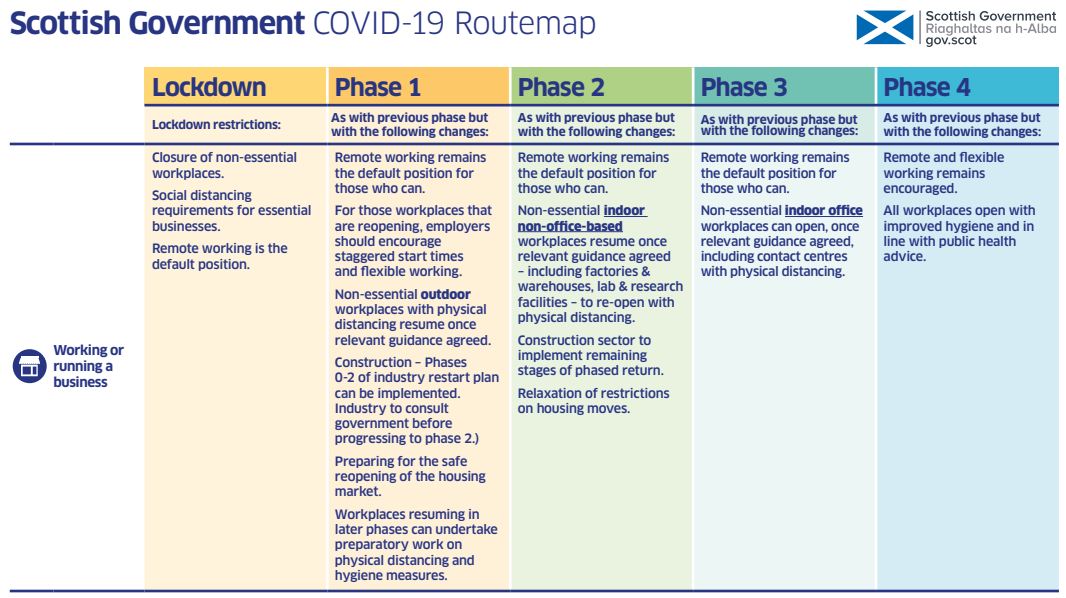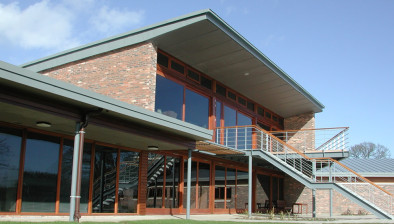Government outlines plan for phased return of construction next week
The construction sector could return to work on a phased basis from May 28 under a new framework announced today by the Scottish Government.

Unveiling its route map out of the current lockdown restrictions, the government said it is planning for outdoor workplaces to resume as part of the first phase out of lockdown, with physical distancing measures in place and staggered start times and flexible working encouraged.
The construction sector will be instructed to implement the first two phases in its restart plan with a decision to move to ‘phase 2’ of the construction sector’s plan only after consulting with government to ensure it is safe to do so in line with public health advice.
The government is also preparing for the safe reopening of the housing market as part of this first phase, with a relaxation of restrictions on housing moves taking place in phase 2.
First Minister Nicola Sturgeon said: “The construction industry will be able to carefully implement steps one and two of its six-step restart plan, which it has developed with us. However, let me be clear, that there must be a genuine partnership with trade unions – this can only be done, if it is done safely.”
The industry-agreed six-step phased model for the return of the construction sector is as follows…
- Phase 0: Planning
- Phase 1: Covid-19 Pre-start Site prep
- Phase 2: ‘Soft start’ to site works (only where physical distancing can be maintained)
- Phase 3: Steady state operation (only where physical distancing can be maintained)
- Phase 4: Steady state operation (where physical distancing can be maintained and/or with PPE use)
- Phase 5: Increasing density/productivity with experience
In a letter to Ken Gillespie, chair of Construction Scotland and member of the Construction Leadership Forum, housing Minister Kevin Stewart said the current coronavirus construction sector guidance will be updated to incorporate this approach.
Mr Stewart wrote: “In terms of your proposed Phase 0, I understand that work is progressing well on preparing site assessments for Covid-19 modifications and developing the necessary new procedures, building on the valuable experience gleaned from ongoing essential works such as Scotland’s temporary coronavirus hospital, the NHS Louisa Jordan.
“We also believe that, subject to positive outcome from the review on May 28th we are now ready to move to your Phase 1, the advance preparation of non-essential sites. The work in this stage will facilitate physical distancing and enhanced hygiene, including Installing new or expanding existing site welfare and toilet facilities, “one way” systems and marking 2m distancing throughout the site.
“Depending on the evidence emerging from this initial stage and subject to Health and Safety statutory requirements being satisfied, we can then look forward to commencing Phase 2 –Soft Start, with its phased return of a proportion of the workforce. I note your commitment that no element of non-essential works requiring the use of PPE above the standard industry use, will commence at this stage. We will also require you to consult with government for agreement before progressing to Phase 2, and in any case will not approve such a move until a minimum of 2 weeks after we publish updated advice, though we will keep this under review.”
Vaughan Hart, managing director of Scottish Building Federation (SBF), said: “I welcome the fact the Scottish Government have given priority to the construction industry returning to work but many of our members have already spent the past weeks undertaking the kind of preparatory work envisaged to ensure sites are safe and will be ready to begin building works through a ‘soft start’ either immediately or by the end of May. It is critical the Scottish Government gives the go-ahead for that as soon as reasonably possible and then for the further stages of the plan so that construction can begin to gradually increase activity whilst keeping site safety as the top priority.
“As urged by the First Minister, the Scottish Building Federation will continue to work closely with the trades unions to ensure collective collaboration which will also assist with the safe return to work. We have a long-standing working relationship with the trades unions and welcome their support and collaboration as the industry returns to work.”
Hew Edgar, RICS head of UK Government relations and city strategy, said: “The Scottish Government should be commended for it’s clear messaging on health measures thus far; and we welcome the publication of this ‘route map’ back to a new, post-lockdown ‘normal’.
“Needless to say, health is Scotland’s top priority, but RICS, like all participants in the built environment, has been eager for the publication of this long-awaited report. The uncertainty regarding an unknown return date has been inhibiting practitioners’ and companies’ potential to plan and prepare for the emergence from the lockdown, and this has been severely detrimental to industry activity, output and the wider economy.
“The report mentions that we will enter the first two phases of the six-phase return plan for construction, and we welcome the government’s plans to engage with unions over the safe return to work. Likewise, the provision of this timeline is valuable, and will be welcomed by industry– particularly for supply chain management – as it will allow businesses to bring staff back from furlough and mobilise supply chains as they begin to recommence activity. However, we have heard from many industry participants that this six-phase plan is not widely available or easy to locate. As such, we would urge the Government to undertake a programme of awareness raising.”
Mr Edgar said the document is lacking clearer guidance with regard to the housing market. Phase 1: Preparing for the safe reopening of the housing market; and Phase 2: Relaxation of restrictions on housing moves are “not clear enough, and this ambiguity will cause confusion on what is, and what is not, allowed”, he added.
“Whilst the First Minister stated that further guidance will be developed, which we look forward to, the housing market would significantly benefit from greater clarity on when operators can renew their activities in a market which is so important to the economy,” Mr Edgar went on.
“Indeed, the last thing the housing market needs is a creeping delay arising from an ambiguous restart date. Clearer messaging would allow residential property businesses to bring furloughed staff back at the right time; for tenants to assemble a deposit; and for potential buyers to arrange a mortgage. This would mean that when the restrictions are lifted, the market could hit the ground running as a means to contribute to what we hope will be a V-shaped recovery.
“Now that the route map is published, the government and parliament should look to the post-pandemic recovery and what levers can be utilised to rebuild confidence and stability, as well as boost activity in the built environment. Government and parliament should also look at how we can use this opportunity to reflect on existing practices and assess whether Scotland can reset its approach to the built environment in order to align with a green recovery.”
Scott Johnston, Aberdeen-based partner and construction specialist at Pinsent Masons, said: “The Scottish construction industry is under massive financial strain created by the lockdown and it is to be commended for its discipline and compliance to date with government advice.
“But contractors and the supply chain need to get back “on the park” with projects as quickly as this can be safely achieved and it will come as a relief to see at the outline of an exit plan.
“Cash flow is the lifeblood of the industry, and it’s vital for Scotland’s economy that we have a healthy construction sector. The industry is highly safety conscious, and although it will be challenging to implement social distancing measures, it has a history of rising to the occasion when it comes to safely ensuring safe working practices.”
Tracy Black, CBI Scotland director, said: “Businesses across Scotland will welcome the publication of a route map for economic restart that puts safety first. Unless people feel safe, employees won’t return to work, customers will stay away and the restart will falter, putting people’s livelihoods at further risk.
“The four phases outlined provide a helpful starting point for firms preparing for the restart and those already working hard to ensure their operations are as safe as possible for staff and customers. For the Scottish construction industry, which has been hit so hard by the crisis, the resumption of activity in phase one will come as a significant relief.
“While businesses recognise that timings may vary based on scientific evidence, the principles and guidance that underpin the restart should be transparent and as consistent as possible across the UK. With the UK Government having already provided a helpful template looking at workplace settings, firms will be keen to see an acceleration of specific workplace guidance for Scotland that follows the same approach.
“Like the rest of the UK, Scotland faces months of change and challenge. A unified approach to reopening the economy – involving both governments, business and employee representatives – is vital to instilling public confidence and getting the economy back on its feet.”
STUC general secretary designate Roz Foyer added: “We welcome the FM stressing the importance of any move out of lockdown requiring liaison with trade unions. We demand and expect that where an employer does not currently recognise a union it is compelled to agree terms for union engagement and for the admission to sites of union health and safety officers.”
- Read all of our articles relating to COVID-19 here.

















